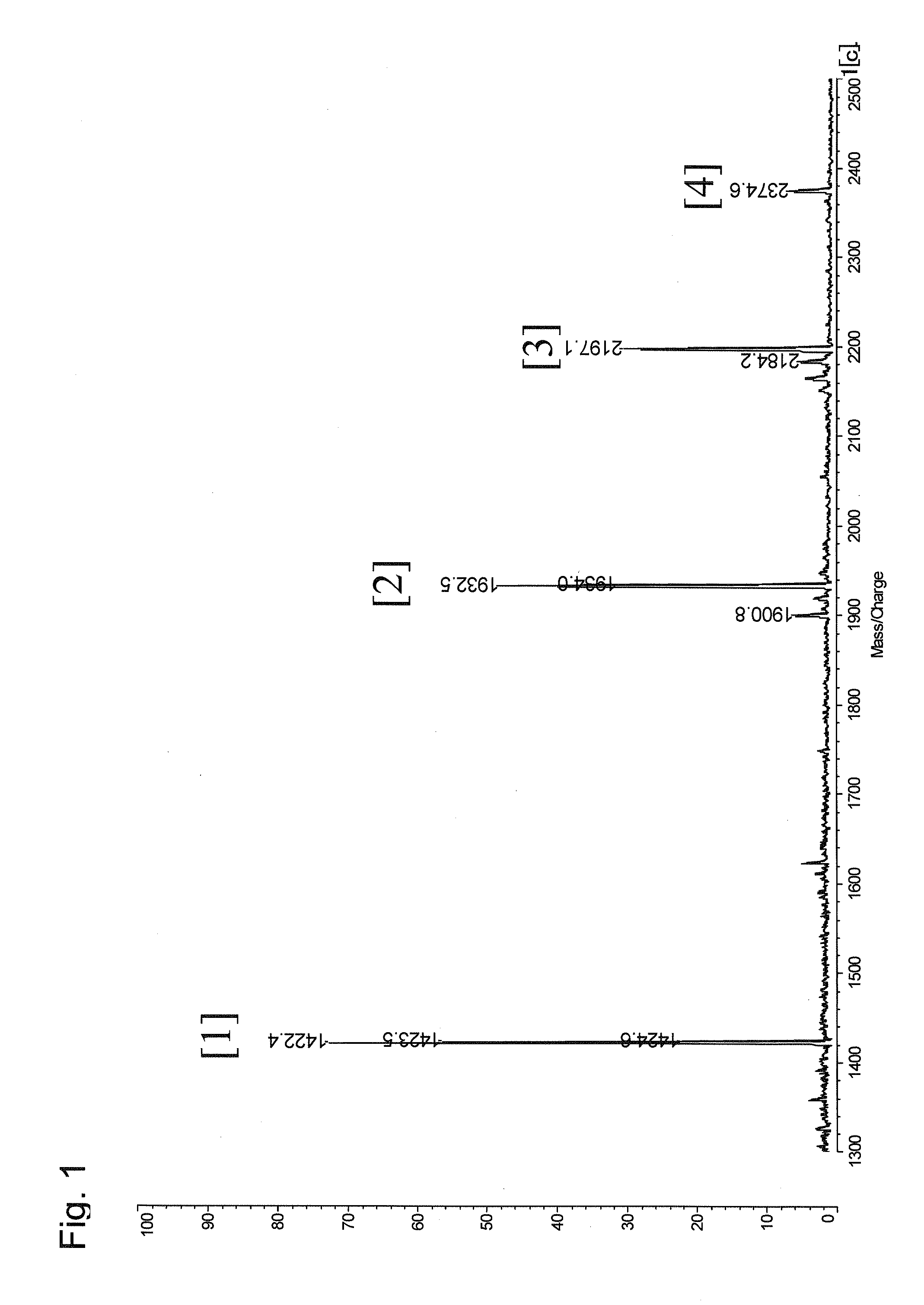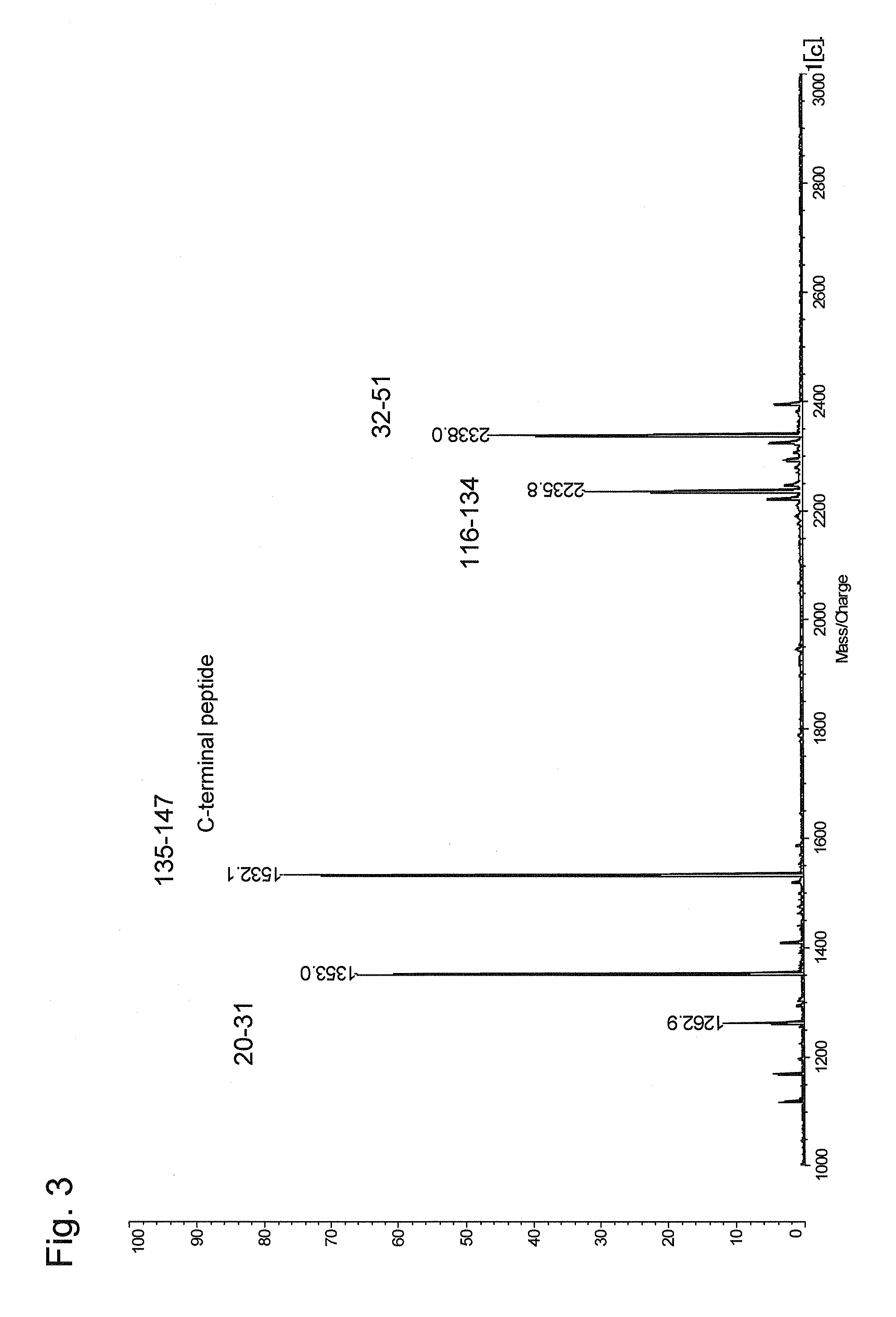Method for selectively recovering c-terminal peptide of protein and method for determining amino acid sequence of c-terminal peptide of protein using the same
a c-terminal peptide and selective recovery technology, applied in the field of selective recovery of c-terminal peptides of proteins, can solve the problems of manual recovery, difficult to determine the sequence of c-terminal peptides by mass spectrometry measurement, and difficult to provide reagent kits, etc., to achieve the effect of easy determination
- Summary
- Abstract
- Description
- Claims
- Application Information
AI Technical Summary
Benefits of technology
Problems solved by technology
Method used
Image
Examples
experimental example 1
Study 1 Using Model Peptides
[0077]In this experimental example, a mixture of 4 kinds of model peptides was prepared, and was then subjected to the method according to the present invention using TMPP-Ac-OSu as a modification reagent.
[0078]More specifically, the following model peptides were used.
[1]WAGGDASGE(SEQ ID No. 1)[2]MHRQETVDCLK-NH2(SEQ ID No. 2)[3]TRDIYETDYYRK(SEQ ID No. 3)[4]AAKIQASFRGHMARKK(SEQ ID No. 4)
[0079]It is to be noted that a residue represented by K—NH2 in the peptide [2] is a lysine residue whose C-terminal carboxyl group has been amidated.
[0080]The mixture of four kinds of model peptides corresponds to a protein cleavage product provided in the present invention. More specifically, the peptide [1] corresponds to a C-terminal peptide fragment, and the peptide fragments [2], [3], and [4] correspond to the other peptide fragments because they have a lysine residue as a C-terminal amino acid residue.
[0081]Equal amounts of the model peptides (100 pmol, 400 pmol in t...
example 1
Study Using Protein
[0087]In this example, lysozyme (chick, egg-white) as a protein of interest was subjected to the method according to the present invention using TMPP-Ac-OSu as a modification reagent.
[0088]100 μg of a freeze-dried sample of lysozyme was dissolved in an aqueous solution containing 8 M urea and 50 mmol NaHCO3, and then 1 μL of an aqueous TCEP solution (prepared by dissolving 5.7 mg of TCEP in 100 μL of water) was added thereto to react them with each other at 37° C. for 30 minutes. Then, 1 μL of an aqueous iodoacetamide solution (prepared by dissolving 9.3 mg of iodoacetamide in 100 μL of water) was added thereto to carry out an alkylation reaction at room temperature for 45 minutes. Then, 200 μL of a Lys-C solution (prepared by dissolving 5 μg of Lys-C in 200 μL of a 50 mmol aqueous NaHCO3 solution) was added thereto to carry out a reaction at 37° C. overnight to digest the protein. The mass spectrum of a protein digest is shown in FIG. 3. As shown in FIG. 3, four...
experimental example 2
Study 2 Using Model Peptides
[0092]In order to determine the effect of improving fragmentation by modifying a side chain of an arginine residue, two kinds of peptides were each subjected to the method according to the present invention using TMPP-Ac-OSu as a modification reagent.
[0093]More specifically, the following model peptides were used.
[5]RVYIHPF(SEQ ID No. 5)[6]DAEFRHDSGYE(SEQ ID No. 6)
[0094]The model peptides [5] and [6] correspond to C-terminal peptide fragments contained in a protein cleavage product prepared using lysyl endopeptidase in the present invention.
[0095]The model peptide was dissolved in a mixed solution of 100 mM aqueous NaHCO3 solution (pH 8.2)-acetonitrile (volume ratio 1:9) to prepare a 20 pmol / μL solution.
[0096]The TMPP-Ac-Osu was prepared as a 10 mM solution using a mixed solution of acetonitrile-water (volume ratio 2:8) as a solvent.
[0097]45 μL of the model peptide mixture solution was mixed with 5 μL of the 10 mM TMPP-Ac-Osu solution to react them with ...
PUM
| Property | Measurement | Unit |
|---|---|---|
| temperature | aaaaa | aaaaa |
| temperature | aaaaa | aaaaa |
| reaction time | aaaaa | aaaaa |
Abstract
Description
Claims
Application Information
 Login to View More
Login to View More - R&D
- Intellectual Property
- Life Sciences
- Materials
- Tech Scout
- Unparalleled Data Quality
- Higher Quality Content
- 60% Fewer Hallucinations
Browse by: Latest US Patents, China's latest patents, Technical Efficacy Thesaurus, Application Domain, Technology Topic, Popular Technical Reports.
© 2025 PatSnap. All rights reserved.Legal|Privacy policy|Modern Slavery Act Transparency Statement|Sitemap|About US| Contact US: help@patsnap.com



